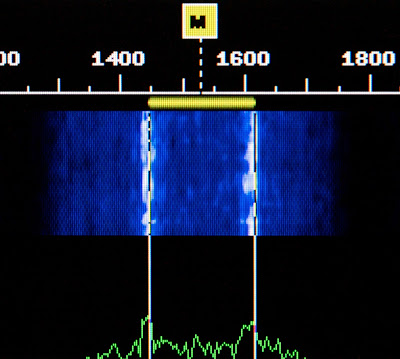Some random thoughts and observations about RTTY operation with the K3 and DM780 follow…
The DM780 + HRD Logbook combination did fairly well, considering HB9DRV himself says “HRD/DM780 is not contest software.” As such, there is no easy provision for sending or receiving QTC info for extra multipliers, and it wasn’t clear at first how to get DM780 to increment serial numbers in the exchange field (put them in [brackets], I finally discovered). Using a fresh database file for the log (as I do for every contest) lets me use the logbook’s Awards Tracking and Worked Status functions to keep an eye on what stations and countries I’ve worked on each band, but I have to be careful to individually set the other databases (previous contest logs, plus my master logbook) to not figure into the worked status lookups (this is one in the Logbook Databases control panel).
Another limitation from a contesting perspective is HRD Logbook’s inability to output Cabrillo files for log submission after the test, a feature that was available in HRD v4. So I have to use another app (SP7DQR’S nice
ADIF2CABR freeware app) to convert an ADIF export file into Cabrillo format, and that only after doing a search-and-replace on the ADIF file to change the
tag to that the conversion app is looking for. No biggie, I mud-wrestle data for a living, so this is just another day at the office…That said… I’m familiar and comfortable with DM780 and HRD Logbook so it all worked just fine for me.
I worked the first day with the K3 in DATA A mode before remembering that AFSK A mode allows DUAL PB filtering to peak the mark and space tones. The DM780 waterfall screenshots below illustrate the difference far better than words:
K3 set to DATA A mode. BW = 400 Hz, Fc = 1530 Hz

K3 set to AFSK A mode. BW = 400 Hz, Fc = 1530 Hz, DUAL PB enabled
Note that the overall bandwidth in AFSK A mode is quite a bit narrower, even though in both cases the K3 was set to 400 Hz, and the distinct notch between mark and space tones is indicative of how effective this filtering mode works. Back in the pre-DSP days with the TS-930S and JST-135/245 transceivers and NRD-525/535 receivers, I used to use a Datong FL-3 audio filter which had a RTTY mode that accomplished the same thing, albeit at the AF stage.
DATA A and AFSK A each have their advantages. In DATA A (or AFSK A with DUAL PB turned off), I can open the bandwidth up and see a good portion of the band (I generally set DM780 to display 3 kHz on the waterfall and set the K3 bandwidth to match) and all the signals on the air, then select the desired signals with a point-and-click like I do in PSK31 mode. If QRM is a problem, I can crank down the bandwidth and shift the passband center frequency to pass only the station I’m working; once the QSO is complete, a quick tap-twist of the K3’s shift control recalls my wide settings and I’m back on the hunt. I rarely touch the VFO dial, all tuning is done with the mouse.
In AFSK A mode with DUAL PB enabled, however, the K3’s center frequency is fixed at 1530 Hz so all tuning must be done with the VFO. Also, the bandwidth is limited to 500 Hz max (which as shown in the image above is a bit less in practice, more like 250 Hz or so) making VFO tuning very touchy and slow (the 1 Hz fine steps must be used) and renders the waterfall useless for spotting other signals. But the filtering advantage is huge, especially in a contest scenario.
For me, it’s a no brainer — in the latter stages of the WAE contest I found myself using DUAL PB almost exclusively, occasionally switching it off and opening up the bandwidth if the band was quiet or if I’ve already worked the majority of the stations I tune across, since clicking on a waterfall makes it far easier to hunt and pounce.
DM780 facilitates the switch from narrow DUAL PB to wideband waterfall tuning easily: I first activate the center frequency marker (Tools>Program Options>Waterfall menu, or F8) and set it to match the K3 DUAL PB center frequency (1530 Hz). After finding a signal on the waterfall and clicking on it, I can then click the C button just above the waterfall to center it at 1530 Hz (HRD offsets the K3 VFO frequency to do this), and then activate the DUAL PB (press/hold the #6 key on the K3 keypad). The bandwidth is narrowed to 500 Hz, and the mark and space tones are perfectly positioned for decoding. To switch back to wideband, press/hold DUAL PB, and tap XFIL a couple of times to select the 2.7 kHz filter or use one of the filter presets to select my standard wide data setting of 3 kHz. This can perhaps be simplified to a one-button process using the new macro feature Elecraft just added to the latest firmware version; I need to check into that…
Note to K3 users: when working RTTY in AFSK A mode, either the radio or DM780 needs to be set to reverse, as AFSK A demodulates the lower sideband while DM780 looks for the upper. DATA A, however, works in the upper sideband.
 Waiting for Baudot
Waiting for Baudot














